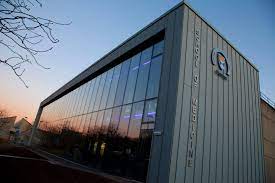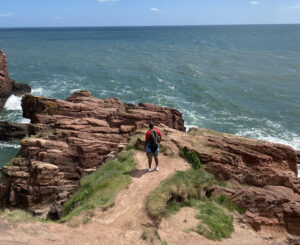Author: E. Nathaniel McBride
 A man enters a gate that will lead to a new world. As he boards the cramped plane, a baby cries, and a senior man chuckles to his wife. A flight attendant reassures a mother that her son will be okay not sitting next to her. And a first-time-flyer looks out the window, hoping to get one last look at the beautiful city of San Francisco. Eventually, the man sits down, already missing home and desiring to be at his destination. The man is anxious, feeling the butterflies move throughout his body as if they, too want to escape to their home. But, he is also content, ready for foreign to become familiar.
A man enters a gate that will lead to a new world. As he boards the cramped plane, a baby cries, and a senior man chuckles to his wife. A flight attendant reassures a mother that her son will be okay not sitting next to her. And a first-time-flyer looks out the window, hoping to get one last look at the beautiful city of San Francisco. Eventually, the man sits down, already missing home and desiring to be at his destination. The man is anxious, feeling the butterflies move throughout his body as if they, too want to escape to their home. But, he is also content, ready for foreign to become familiar.
As a non-BME (Biomedical Engineer) major, I was initially apprehensive about traveling to a foreign country and learning about a topic that was also foreign to me. However, the thought of being able to experience and explore life as well as healthcare design in a new way was mesmerizing, and I was determined to overcome my nervousness. Fortunately, my mindset changed within a few days of arriving in Scotland, not only because of my kind peers but also the hands-on experience I was amassing.

During our stay in Dundee, we traveled to the Center for Anatomy and Human Identification at the University of Dundee where we toured the facility and learned about the embalming process that utilizes a thiel system. Using thiel allows for more flexibility of the cadaver and better maintains the fascial layers between structures of the body. The only downside to using theil is that the brain essentially deteriorates and becomes, for lack of better words, “mush”. To account for this issue, embalmers will remove the brain before starting the process if they intend to preserve it. At the facility, I also had the opportunity to “glove-up” and physically examine the insides of one of the cadavers. It was surreal holding the human heart among other organs and visually observing the tendons, muscles, and ligaments that lie under our skin.
While the Center for Anatomy and Human Identification is not directly related to healthcare, it allows students and even those who are just curious to gain an understanding of the human body. The center contributes to a sustainable and quality healthcare design by ensuring that individuals have access to clean and optimal cadavers. This is crucial because cadavers allow future doctors, dentists, scientists, and engineers to get hands-on experience with real human beings.

It was after we visited the center that I had a revelation. Not only was I empowered, but I also realized that I was in the right place with the right people at the right time. I no longer needed to be nervous about BME, and could instead embrace the unknown.

